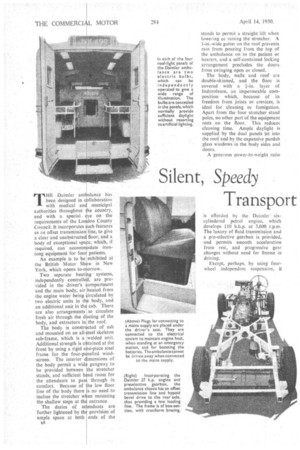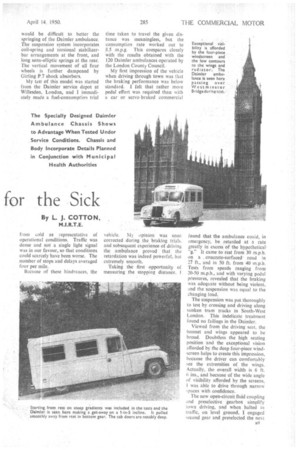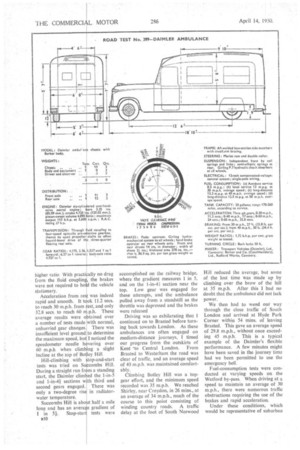Silent Speedy Transport
Page 42

Page 43

Page 44

Page 45

If you've noticed an error in this article please click here to report it so we can fix it.
for the Sick
By L. J. COTTON,
M.1.R.T.E.
THE Daimler am ulance has been designed in c llabOration with medical an municipal authorities throughout he country, and with a special ye on the requirements of the Lc) don County Council. It incorporates uch features as an offset transmission line, to give a clear and unobstructe floor, and a body of exceptional spa e, which, if required, can accorn idate ironlung equipment for fou patients.
An example is to be exhibited at the British Motor. Sh w in New York, which opens toorrow.
Two separate heati g systems, independently controlle , are provided in the driver's ompartment and the main body, air heated from the engine water being irculated by two electric units in t body, and an additional unit in th cab. There are also arrangements to circulate fresh air through the d icting of the body, and extractors in the roof.
The body is constr cted of ash and mounted on an allteel skeleton sub-frame, which is 'a welded unit. Additional strength is o tained at the front by using a rigid o e-piece steel frame for the four-p nelled windscreen. The interior • imensions of the body permit a wid gangway to be provided between he stretcher stands, and sufficient h ad room for the attendants to pas through in comfort. Because of he low floor line of the body there s no need to incline the stretcher w en mounting the shallow steps at th entrance.
The duties of at endants are further lightened by th provision of ample space at both ends of the stands to permit a straight lift when lowering or raising the stretcher. A 1-in.-wide gutter on the root prevents rain from pouring from the top of the ambulance on to the patient or bearers, and a self-contained locking arrangement precludes the doors from swinging open or closed.
The body, walls and roof are double-skinned, and the floor is covered with a c--in. layer of Induroleum, an impermeable composition which, because of its freedom from joints or crevices, is ideal for cleaning or fumigation. Apart from the four stretcher stand poles, no other part of the equipment rests on the floor. This reduces cleaning time. Ample daylight is supplied by the dual panels let into the roof and by the expansive purdah glass windows in the body sides and doors.
A generous power-to-weight ratio is afforded by the Daimler sixcylindered petrol engine, which develops 110 b.h.p. at 3,600 r.p.m. The luxury of fluid transmission and a pre-selective gearbox is provided, and permits smooth acceleration from rest, and progressive gear changes without need for finesse in driving.
Except, perhaps, by using fourwheel independent suspension, it
would be difficult to better the springing of the Daimler ambulance. The suspension system incorporates coil-spring and torsional stabilizerbar arrangements at the front, and long semi-elliptic springs at the rear. The vertical movement of all four wheels is further dampened by Girling P.7 shock absorbers.
My test of this model was started from the Daimler service depot at Willesden. London, and I immediately made a fuel-consumption trial from cold as representative of operational conditions. Traffic was dense and not a single light signal was in our favour, so that conditions could scarcely have been worse. The number of stops and delays averaged four per mile.
Because of these hindrances, the time taken to travel the given distance was meaningless, but the consumption rate worked out to 8.5 m.p.g. This compares closely with the results obtained with the 120 Daimler ambulances operated by the London County Council.
My first impression of the vehicle when driving through town was that the braking performance was below standard. I felt that rather more pedal effort was required than with a car or servo 'braked commercial vehicle. M■,.. opinion was soon corrected during the braking trials. and subsequent experience of driving the ambulance proved that• the retardation was indeed powerful, but extremely smooth.
Taking the first opportunity of measuring the stopping distance. I
found that the ambulance could, in emergency, be retarded at a rate greatly in excess of the hypothetical "g." It came to rest from 30 m.p.h. on a concrete-surfaced road in 27 ft., and in 50 ft. from 40 in.p.h. Tests from speeds ranging from 20-50 m.p.h., and with varying pedal pressures, revealed that the braking was adequate without being violent, and the suspension was equal to the changing load.
The suspension was put thoroughly to test by crossing and driving along sunken tram tracks in South-West London. This indelicate treatment found no failings in the Daimler.
Viewed from the driving seat, the bonnet and wings appeared to be broad. Doubtless the high seating position and the exceptional vision afforded by the deep four-piece windscreen helps to create this impression, because the driver can comfortably see the extremities of the wings. Actually, the overall width is 6 ft. 6 ins., and because of the wide angle of visibility afforded by the screens, I was able to drive through narrow ,,paces with confidence.
The new open-circuit fluid coupling and preselective gearbox simplify town driving, and when halted in traffic, on level ground, I engaged second gear and preselected the next higher ratio. With practi ally no drag from the fluid couplin the brakes were not required to ho the vehicle stationary.
Acceleration from. res was indeed rapid and smooth. It t ok 11.2 secs. to reach 30 m.p.h. from est, and only 32.8 secs. to reach 60 .p.h. These average results were o tamed over a number of tests made with normal, unhurried gear changes. There was insufficient level ground to determine the maximum speed, but I noticed the speedometer needle hovering over 60 m.p.h when climbing a slight incline at the top of Botley Hill Hill-climbing with stop-and-start tests was tried on Succombs Hill. During a straight run from a standing start, the Daimler climbed the 1-in-5 and 1-in-41sections w th third and second gears engaged. There was only a two-degree rise in radiatorwater temperature.
Succombs Hill is about 'half a mile long and has an average gradient of 1 in 51. Stop-start tests were a10 accomplished on the railway bridge, where the gradient measures 1 in 5, and on the 1-in-4 f section near the top. Low gear was engaged for these attempts, and the ambulance pulled away from a standstill as the throttle was depressed and the brakes were released Driving was so exhilarating that I continued on to Brasted before turning back towards London. As these ambulances are often engaged on medium-distance journeys, I timed our progress from the outskirts of Kent to Central London. From Brasted to Westerham the road was clear of traffic, and an average speed of 40 m.p.h. was maintained comfortably.
Climbing Botley Hill was a topgear effort, and the minimum speed recorded was 35 m.p.h. We reached Shirley, near Croydon, in 26 mins., at an average of 34 m.p.h., much of the course to this point consisting of winding country roads. A traffic delay at the foot of South Norwood Hill reduced the average, but some of the lost time was made up by climbing over the brow of the hill at 35 m.p.h. After this I had no doubt that the ambulance did not lack power.
We then had to wend our way through the close traffic of South London and arrived at Hyde Park Corner within 54 mins. of leaving Brasted. This gave an average speed of 29.8 m.p.h., without once exceeding 45 m.p.h. This is a typical example of the Daimler's flexible performance. A few minutes might have been saved in the journey time had we been permitted to use the emergency bell.
Fuel-consumption tests were conducted at varying speeds on the Watford by-pass. When driving at a speed to maintain an average of 30 m.p.h., there were numerous traffic obstructions requiring the use of the brakes and rapid acceleration.
Under these conditions, which would be representative of suburban
service, the Daimler yielded a fuel return of 13 m.p.g. During the second test, when driving at 40-45 .m.p.h., we were able to keep pace with the faster stream of traffic, and a clean run was made without resorting to severe braking. The engine was notably smooth at this speed and a fuel return of 13.3 m.p.g. was obtained, despite the higher average speed of 40 m.p.h.
At an average road speed of 50 m.p.h., the engine continued to operate quietly and efficiently, and a passenger in the ambulance would be no less comfortable at this speed than at a slower pace. We had to drive well in excess of 50 m.p.h. to maintain a high average speed, hut this had no great effect on the fuel consumption, which equalled, 12.5 m.p.g.
In excess of 60 m.p.h., the additional engine and wind noises gave indication that the vehicle was travelling fast, and I would say that 55 m.p.h. would be a comfortable maximum speed for carrying patients on a long-distance journey.
I returned the Daimler ambulance to Willesden, satisfied that it is a vehicle which will, find favour with municipal and medical authorities. The chassis is specially designed for ambulance work, and with the welltried components fitted it should continue to give good service over a long period.
It has special features which enhance its value as a casualty ambulance, such as provision for plugging-in to an electrical mains supply for boosting the batteries and• maintaining engine heat when standing at an emergency station As these connections are all situated by the driver's seat, the door cannot be dosed until they are disconnected.




























































































